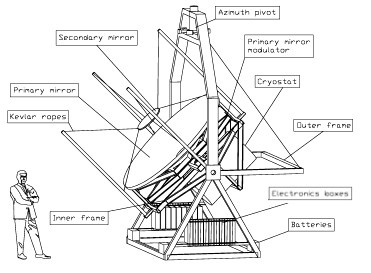Purpose of the flight and payload description
OLIMPO is a mm/sub-mm waves telescope, with a 2.6 meter diameter primary coupled to four arrays of cryogenic detectors working in the 150, 220, 350, 480 GHz bands. This range extends at high frequency and with similar resolution the observations of 10 meter-class ground-based telescopes. The instrument is meant to work at an altitude of 38 km, flying with a stratospheric balloon, in a long-duration circumpolar flight during the arctic summer, taking advantage of the extreme transparency of the stratosphere.
The OLIMPO experiment uses the Cosmic Microwave Background (CMB) as a backlight to study the largest structures in the Universe. It is optimized to detect the inverse Compton scattering of CMB photons crossing clusters of galaxies (also known as the Sunyaev-Zeldovich effect, or SZ). Using the SZ, OLIMPO can detect very distant galaxy clusters, which could not be detected in other ways. Additional science targets of OLIMPO are the spectral-spatial anistropies of the CMB and neutrino masses from high-angular resolution maps of the CMB.
At left we can see a detailed scheme of the telescope on his gondola. The mm-wave telescope of OLIMPO has a 2.6 m diameter primary mirror and a 0.6 m diameter secondary. Based on a classical Ritchey-Chretien configuration, the telescope has been optimized to scan the sky by tilting the primary mirror around a cross-elevation axis. The telescope is protected by a set of large, optimized ground-shields and sun-shields, to limit the effect of straylight and sidelobes. The focus of the telescope is located inside the cryostat. The beam is reimaged through a set of 3 cold mirrors, the second one being the cold stop of the system, and split by 3 dychroic beamsplitters into 4 photometric channels, each one containing one array of bolometers. An innovative differential Fourier Transform Spectrometer is used to achieve moderate spectral resolution (2-6 GHz) within the 4 detection bands.
The cryogenic system is a classical LN/LHe aluminum cryostat with a 3He refrigerator. Both are improved versions of the ones used in the BOOMERanG instrument. Its purpose is to cool the detector arrays at 0.3K, and the reimaging optics (filters, mirrors, cold Lyot stop) at 1.6k. The hold time or autonomy of the 3He refrigerator at 0.3K is about 12 days, with a re-cycling time of 8 hours while for the LHe and LN fluids the autonomy is about 14 days.
The detectors used for OLIMPO are Kinetic Inductance Detectors developed in a collaboration between Sapienza, IFN-CNR and Arizona Sate University. These detectors are close to be photon noise limited in the stratospheric environment with a room-temperature telescope and FTS.
The OLIMPO attitude control system is composed of a tiltable inner frame, including the telescope, the spectrometer and the detectors cryostat, and an outer frame containing all the other systems and connected to the balloon through an azimuth pivot and the flight chain. OLIMPO points the desired sky region using a combination of azimuth and elevation movements. The azimuth actuators are a flywheel and a motor torquing against the flight chain. The elevation actuator is a linear motor modifying the tilt of the inner frame with respect to the outer frame. The attitude sensors for real-time control are a set of 3-axis laser gyroscopes, while the elevation sensor is a 16-bit optical encoder. The main sensor for attitude reconstruction is a red/IR star camera, able to detect all the stars of magnitude 7 in a 2º x 2º field.
Details of the balloon flight
Balloon launched on: 7/3/2018
Launch site: Longyearbyen Airport, Svalbard, Norway
Balloon launched by: Italian Space Agency (ASI) / Swedish Space Corporation (SSC)
Balloon manufacturer/size/composition: Zero Pressure Balloon Aerostar - 1.200.000 m3
End of flight (L for landing time, W for last contact, otherwise termination time): 7/3/2018
Landing site: Balloon failure at launch
The launch operations were performed on July 3th, 2018 from the Svalbard airport in Longyearbyen. The balloon was laid out along the runway and the inflation process started with strong crossed winds with gusts that difficulted the operation. At a certain moment -during the initial portion of the inflation process before the bubble was erected- the crossed winds were strong enough to make the balloon fabric touch the asphalt of the runway, then as a result of the stress suffered the balloon developed a large tear forcing the team to abort the launch. The flight was finally launched with success on July 14th.
External references
- OLIMPO website Universita di Roma, La Sapienza
- OLIMPO Memorie della Società Astronomica Italiana, v.79, p.887 (2008)
- OLIMPO: a Balloon-Borne SZE Imager to Probe ICM Dynamics and the WHIM proceedings of the mm Universe 2023
- OLIMPO: A few arcmin resolution survey of the sky at mm and sub-mm wavelengths Memorie della Società Astronomica Italiana, v.74, p.96 (2003)
- Preparing launch of OLIMPO from Svalbard Swedish Space Corporation press release
14485If you consider this website interesting or useful, you can help me to keep it up and running with a small donation to cover the operational costs. Just the equivalent of the price of a cup of coffee helps a lot.


